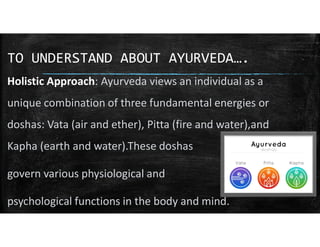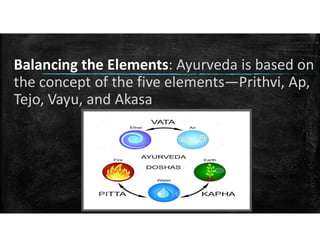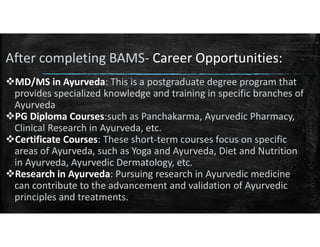KRIYA SHAREERA SCOPE OF AYURVEDA.pdf
- 1. EmpowEring HEaltH witH BamS: a JournEy to HoliStic wEllnESS
- 2. B.A.M.S STANDS FOR? Ō¢¬ BAMS stands for "Bachelor of Ayurvedic Medicine and Surgery." is an undergraduate degree program in the field of Ayurvedic medicine Ō¢¬ The BAMS degree program is recognized by the Central Council of Indian Medicine (CCIM), which is a statutory body under the Ministry of AYUSH (Ayurveda, Yoga & Naturopathy, Unani, Siddha, and Homoeopathy) in India. Ō¢¬ Since 2021, Central Council of Indian Medicine was dissolved and its role was overtaken by National Commission for Indian System of Medicine (NCISM).
- 3. WHAT IS AYURVEDA? ’üČAyurveda is an ancient system of medicine and holistic healing that originated in India over 5,000 years ago. The term "Ayurveda" is derived from the Sanskrit words "Ayur," which means life, and "Veda," which means knowledge or science. Therefore, Ayurveda can be translated as the "science of life" or the "knowledge of longevity."
- 4. TO UNDERSTAND ABOUT AYURVEDAŌĆ”. Holistic Approach: Ayurveda views an individual as a unique combination of three fundamental energies or doshas: Vata (air and ether), Pitta (fire and water),and Kapha (earth and water).These doshas govern various physiological and psychological functions in the body and mind.
- 5. Natural Healing: Ayurveda depends on natural remedies derived from plants, minerals, and animal products. Preventive Healthcare: Ayurveda places a strong emphasis on preventive measures to maintain health and prevent diseases. Practices like daily routines (Dinacharya) and seasonal regimens (Ritucharya).
- 6. Balancing the Elements: Ayurveda is based on the concept of the five elementsŌĆöPrithvi, Ap, Tejo, Vayu, and Akasa
- 7. In recent years, Ayurveda has gained recognition and popularity worldwide for its holistic and natural approach to health and wellness. Complementary to Modern Medicine: Ayurveda can work alongside modern medicine. Ayurveda offers a wide range of treatments, including herbal remedies, dietary modifications, detoxification therapies (Panchakarma), yoga, meditation, and lifestyle recommendations.
- 8. After completing BAMS- Career Opportunities: ’üČMD/MS in Ayurveda: This is a postgraduate degree program that provides specialized knowledge and training in specific branches of Ayurveda ’üČPG Diploma Courses:such as Panchakarma, Ayurvedic Pharmacy, Clinical Research in Ayurveda, etc. ’üČCertificate Courses: These short-term courses focus on specific areas of Ayurveda, such as Yoga and Ayurveda, Diet and Nutrition in Ayurveda, Ayurvedic Dermatology, etc. ’üČResearch in Ayurveda: Pursuing research in Ayurvedic medicine can contribute to the advancement and validation of Ayurvedic principles and treatments.
- 9. ’üČMaster of Public Health (MPH) is a graduate- level degree program , Common specializations include Epidemiology, Health Policy and Management, Global Health, Environmental Health, Community Health, Maternal and Child Health. ’üČ Public Health Policy and Advocacy ’üČ Health Program Management ’üČ Community Health and Wellness ’üČ Academic and Research Institutions ’üČ Nonprofit Organizations and NGOs: Collaborate with organizations ’üČ MPH provides a unique skill set that bridges traditional medicine with modern public health approaches.
- 10. MHM stands for Master of Hospital Management. Graduates of MHM programs are equipped to pursue careers in healthcare management and administration.
- 11. WHAT IS KRIYA SHAREERA? Ayurveda, "Kriya Shareera" refers to the study of physiologica l processes in the body.
- 12. ’üČBASIC CONCEPTS : ’üČ Tridosa ’üČ Saptha dhatu ’üČ Trimala ’üČ Prakriti ’üČ Manas ŌĆō concious union of mind ’üČ Marmas ’üČ It encompasses the understanding of various functions and activities that take place within the human organism, including digestion, metabolism, circulation, respiration, and excretion, among others.
- 13. Importance if Physiology? ’üČUnderstanding normal functions ’üČBasic for clinical reasoning ’üČDiagnostic skills ŌĆō to recognize patterns of dysfunction ’üČTreatment plan ŌĆō select appropriate medicine, therapies, interventions to restore or maintain health ’üČSurgical decision making ’üČPharmacology ’üČResearch and innovation ’üČPreventive medicine ’üČPatient education
- 14. IMPORTANCE OF SHLOKA? ’üČSANSKRIT PLAYS IMPORTANT ROLE IN UNDERSTANDING AYURVEDA. ’üČPresentation in shloks/ sutra rupa it becomes easier to understand and remember the concepts. ’üČPreservation of Knowledge ’üČMemorization and Recitation ’üČAuthenticity and Tradition ’üČAuthenticity and Tradition ’üČReference for Practice and Teaching ’üČOverall, shlokas are a vital component of Ayurvedic education and practice, serving as a bridge between ancient wisdom and contemporary understanding.
- 15. COURSE CURRICULUM FOR FIRST PROFESSIONAL BAMS (PRESCRIBED BY NCISM) ’üČ Subject Code: AyUG KS https://ncismindia.org/AyUG-KS.pdf ’üČTextbook of Physiology - Gyton & Hall ’üČ Review of medical physiology ŌĆōWilliam Ganong ’üČ Essentials of Medical Physiology - Sembulingam, K. ’üČ Concise Medical Physiology - Chaudhari, Sujit. K. ’üČ Fundamental of Anatomy & Physiology - Martini ’üČ Principals of Anatomy & Physiology -Tortora & Grabowski ’üČ Human Physiology - Richards, Pocock ’üČ Samson Wrights Applied Physiology, Keele, Neil, joels ’üČ Ayurveda Kriya Sharira -Yogesh Chandra Mishra ’üČTextbook of Medical Physiology - Indu Khurana
- 16. Add a ║▌║▌▀Ż Title - 5 QR CODE FOR KRIYA SHAREERA SYLLABUS NCISM
- 17. SKILL SET FOR GRADUATES ’üČPatience ’üČMaintenance of Self and environmental hygiene ’üČObservation ’üČConcentration interest about herbs ’üČDecision making ’üČDiagnostic Skills ’üČYoga and Meditation Techniques ’üČEmergency Management Skills ’üČEffective Communication Skills ’üČSkills to educate individuals and communities about Ayurvedic principles, preventive healthcare, and holistic well-being.


















